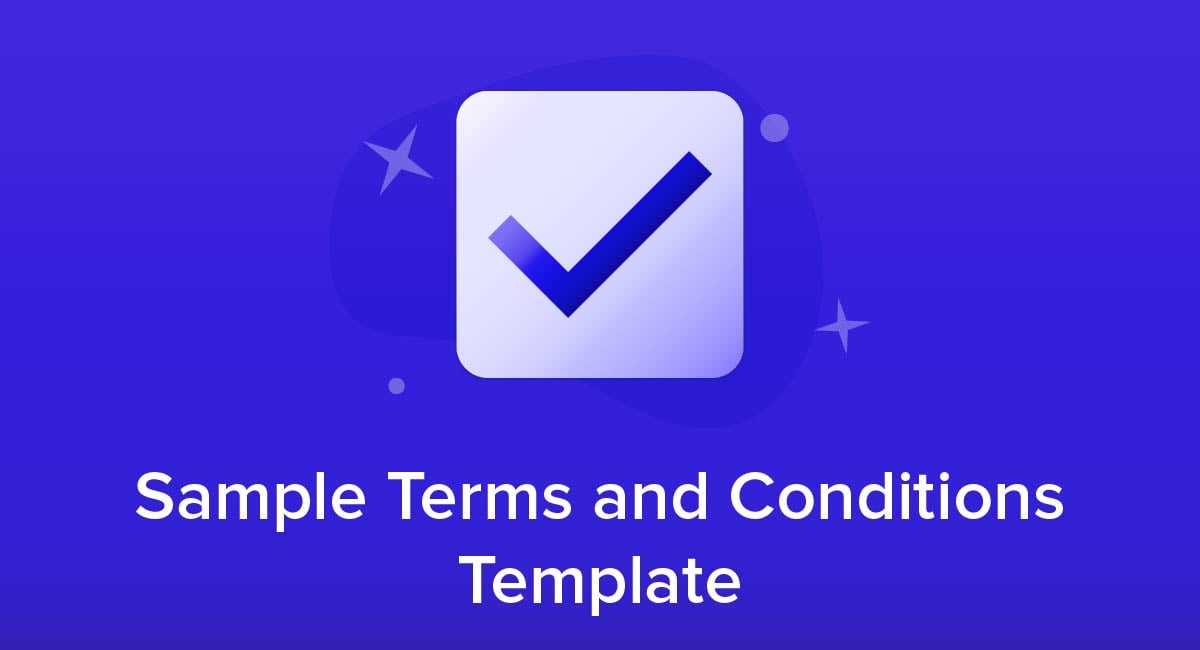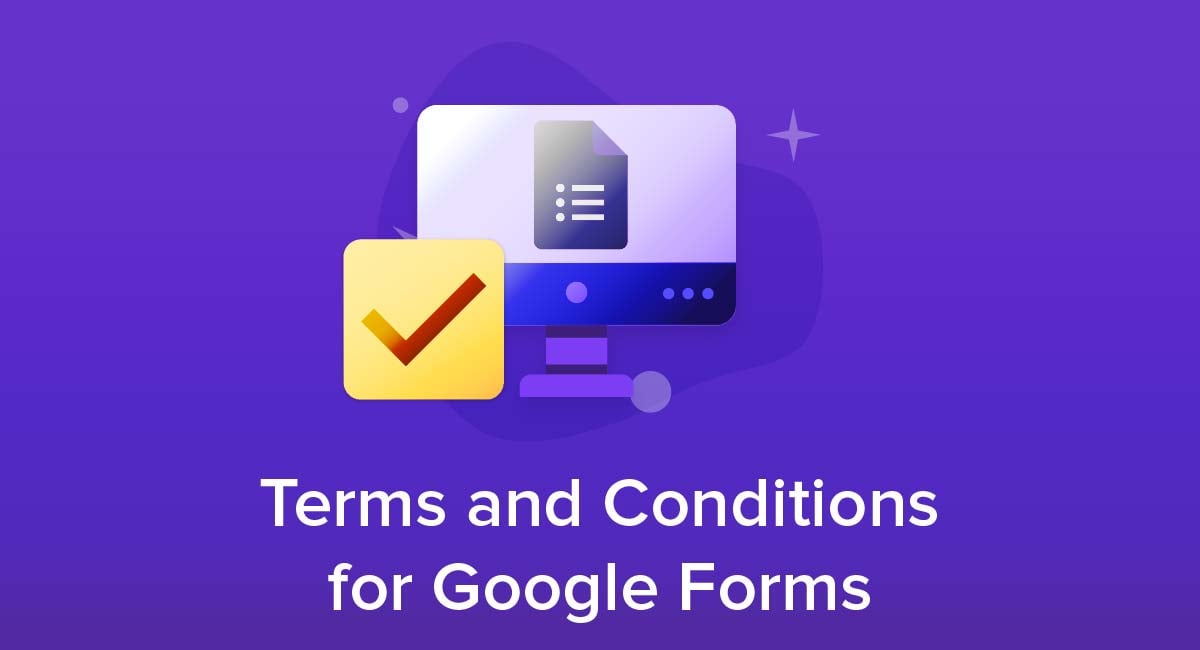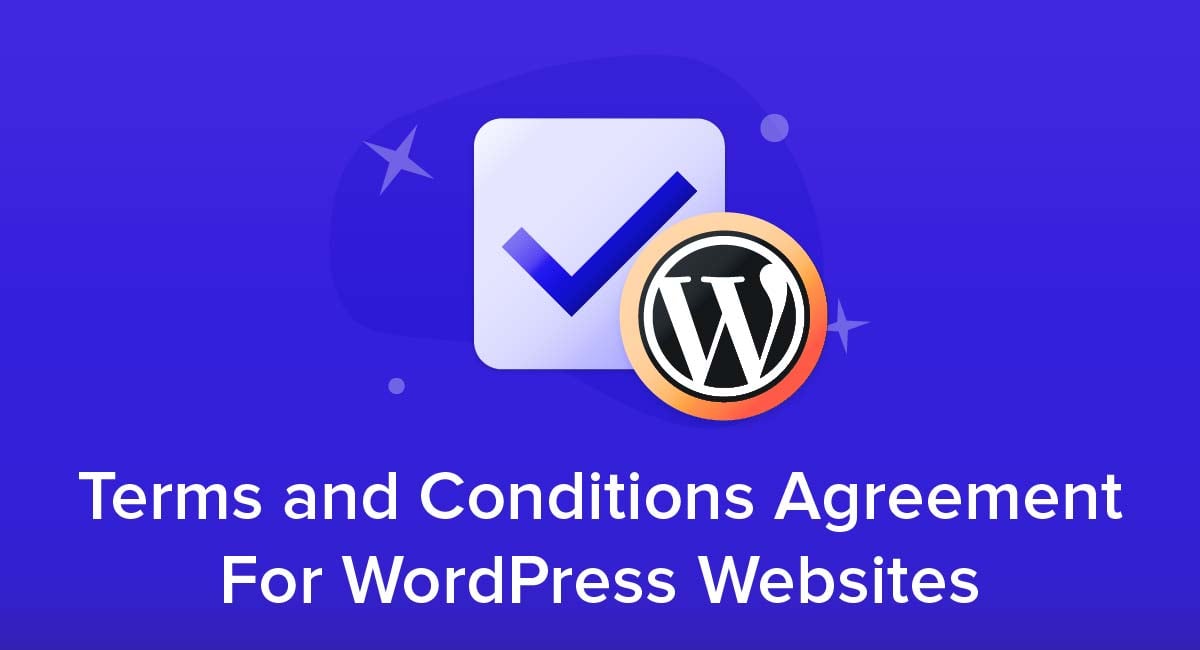
Depending on the content of your WordPress site, you may have a contractual or legal relationship with customers. This could cover selling goods or services, the site itself being a service such as a member only or subscription section, or the way people use site features such as posting user-generated content.
A Terms and Conditions agreement sets out general rules that apply to all such relationships, even when details of specific cases vary.
Here's what you need to know about the benefits of having a Terms and Conditions agreement, how to create your own, and how to display it on your WordPress website.
Our Free Terms and Conditions Generator is created to help you generate a professionally drafted agreement that can include various terms and conditions for your site and/or app.
- Start the Free Terms and Conditions Generator from our website.
- Select platforms where your Terms and Conditions will be used (website, app or both):
- Answer a few questions about your website or app information:
- Select the country:
- Answer a few questions about your business practices:
-
Enter your email address where you'd like to receive the new Free Terms and Conditions and click "Generate":
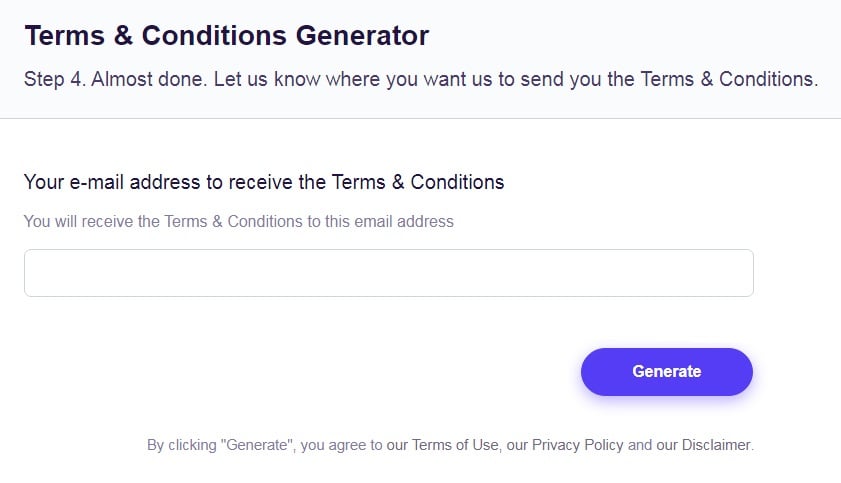
Once generated, you can copy and paste your Free Terms and Conditions agreement on your website or app or link to your hosted Free Terms and Conditions page.
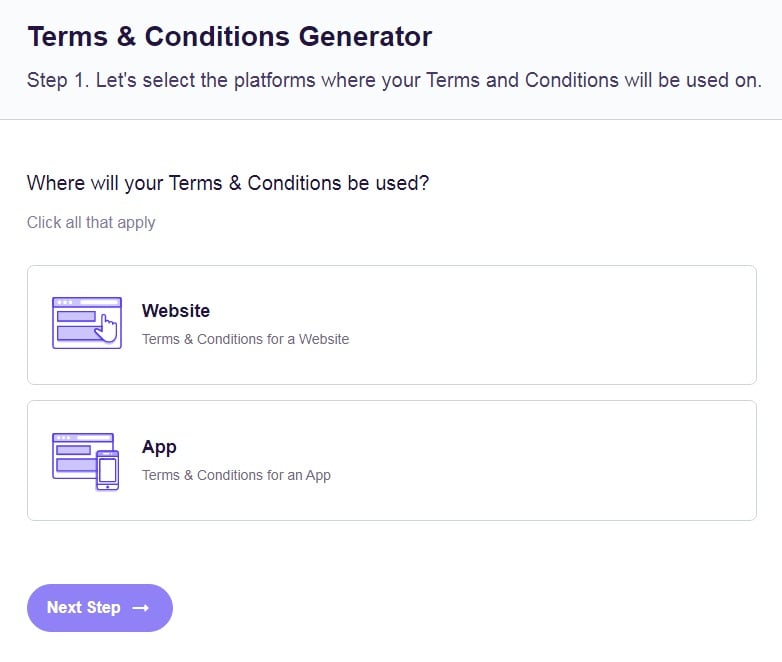
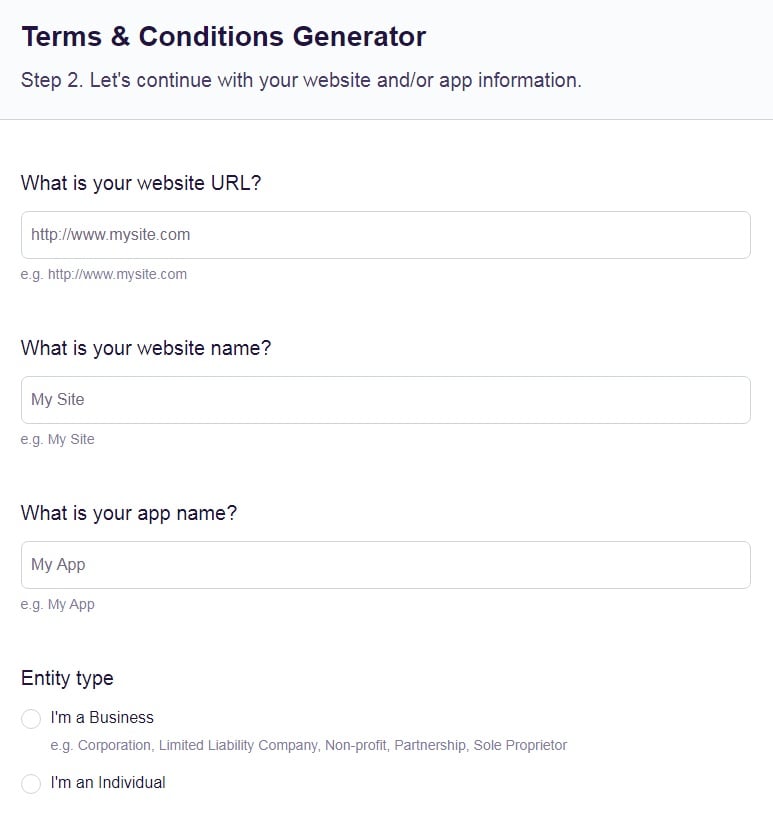
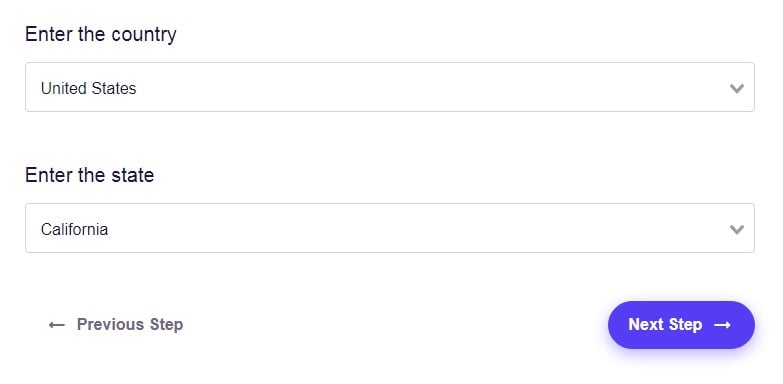
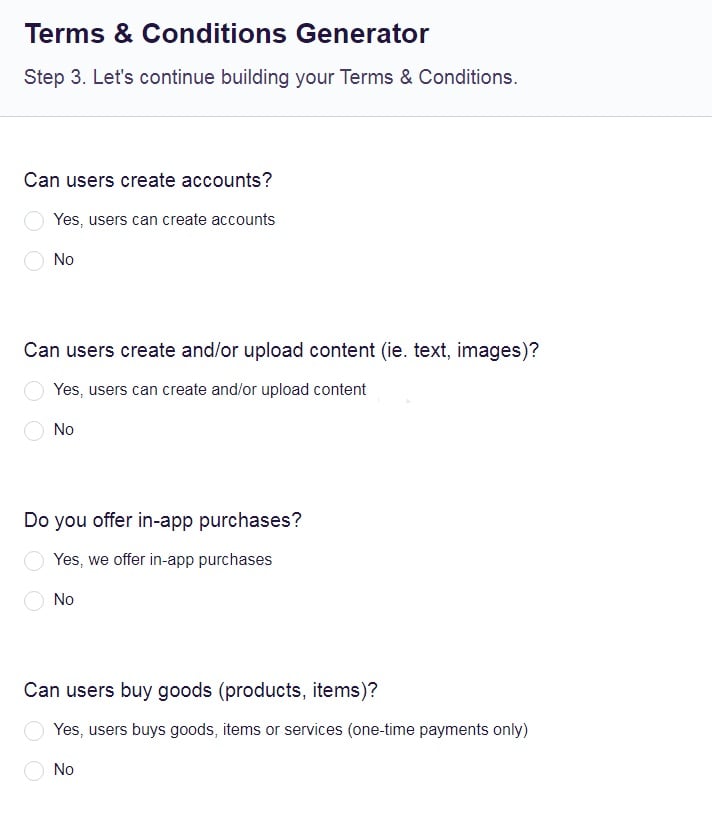
- 1. What is a Terms and Conditions Agreement?
- 2. Why Have a Terms and Conditions Agreement?
- 3. What to Include in a Terms and Conditions Agreement
- 3.1. Restrictions of Use
- 3.2. Account Termination And Other Consequences
- 3.3. Intellectual Property
- 3.4. Disclaimers
- 3.5. Payment Terms
- 3.6. Returns Terms
- 3.7. Liability and Warranty Disclaimers
- 3.8. Governing Law and Jurisdiction
- 4. Where to Display a Terms and Conditions Agreement
- 5. How to Add a Terms and Conditions Page on WordPress
- 6. How to Link to a Terms and Conditions URL Using Widgets on WordPress
- 7. How to Get Agreement For Your Terms and Conditions Agreement
- 8. Summary
What is a Terms and Conditions Agreement?
A Terms and Conditions agreement is a key part of the relationship between two parties, such as a business and customer or a website operator and site users. It's a document setting out the terms and conditions that apply to every purchase, transaction or other interaction between the two parties.
It will cover the rules by which customers can use particular features on your website such as a message board or streaming video section. The key is that the documents set out rules that apply in every case.
You'll sometimes see this agreement under different names such as "Terms of Use" or "Terms of Service." Whatever you call the document, the important thing is that people know about it and understand that it applies alongside any specific points for their particular transaction or relationship.
Why Have a Terms and Conditions Agreement?

Having a Terms and Conditions agreement helps you present your rules to the public, while giving you the ability to enforce your rules. This is incredibly important for maintaining control over your website and business transactions.
Your T&C will help you protect your copyright and intellectual property, help you limit abuses to your site, service or other users, and give you a way to legally limit or remove abusive users and accounts.
A Terms and Conditions agreement will make it easier to enforce any consequences, including in cases other than a specific purchase. For example, if you have a clear terms and conditions agreement you can enforce a rule banning website users from posting inappropriate material, for example by closing their account. If the document was clear and prominent enough, and the user confirmed they agreed to it, they will not be able to plead ignorance about either the rules or the consequences.
Having a Terms and Conditions agreement helps you save space and cut down on repetition. If you listed the full terms and conditions in every transaction, such as on an order confirmation screen, it would be unwieldy and possibly deter people from reading. This could also reduce the prominence of the key details such as what you are selling and the price.
A Terms and Conditions agreement can also reduce the need for duplicated documentation, particularly with printed documents, that could be harder to keep organized.
A Terms and Conditions agreement is a good compromise between excess detail and insufficient detail. Used correctly, it means readers are not overwhelmed with detail, but still have a fair opportunity to read and agree to every element of their legal relationship with you.
What to Include in a Terms and Conditions Agreement

Exactly what to include in a Terms and Conditions agreement will depend on the nature of your site and the relationship with readers. The following are some of the key points you may need to address.
Restrictions of Use
Spell out clearly what users are not allowed to do on your site. This could cover:
- Posting inappropriate material
- Doing anything that could damage the site or harm other users, such as using malware
- Posting discriminatory material
- Posting or delivering unsolicited commercial messages (spam)
Instagram gives clear examples of restrictions on how the platform can be used:
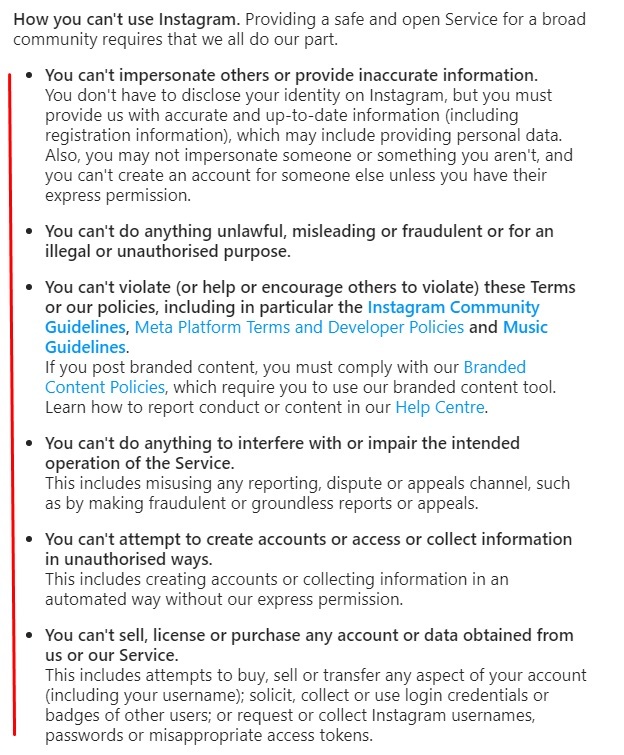
Account Termination And Other Consequences
Explain what can happen if users violate any of the Terms and Conditions. This could include a temporary or permanent ban from using either the site, a member section, or a specific feature. Posting this clearly in your Terms and Conditions agreement will reduce the chances a user claims they have been unfairly punished.
If you do reserve the right to suspend or terminate a user's account, explain what will happen to any material they have previously posted or received (such as user messages) and whether they will be refunded any membership or subscription fees.
HubSpot covers both termination and suspension:
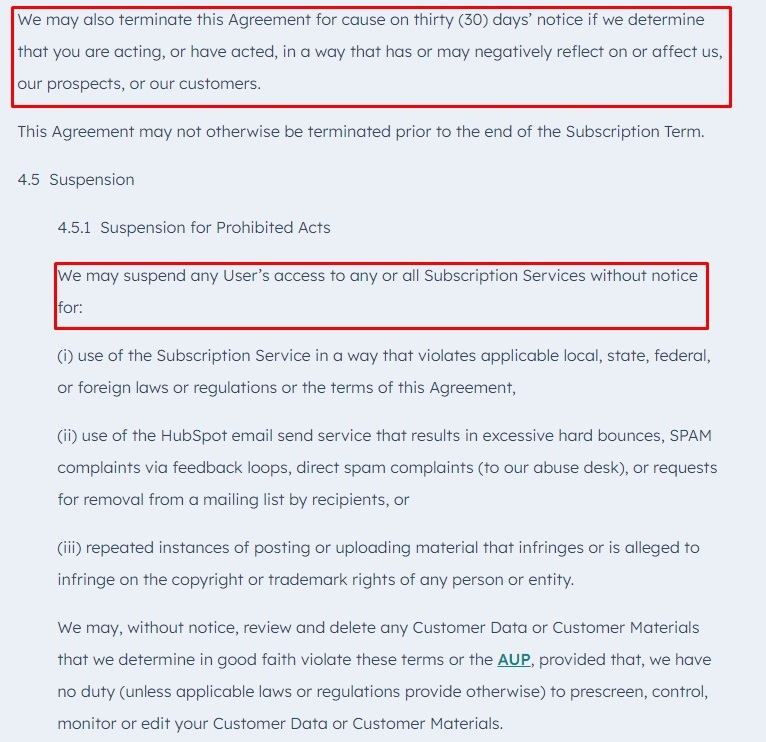
Intellectual Property
Your T&C can help you protect your IP rights when you include relevant information.
Make sure you address the following points:
- That you retain the copyright and trademarks for the material on your site and do not allow reproduction without permission.
- That users must not post any material on your site that violates a third-party's intellectual property.
- How you deal with intellectual property in material that users post. For example, you could require they transfer the copyright. Alternatively, you could say they retain the copyright but give you a license to use it on the site.
DSM covers its intellectual property and that of users:
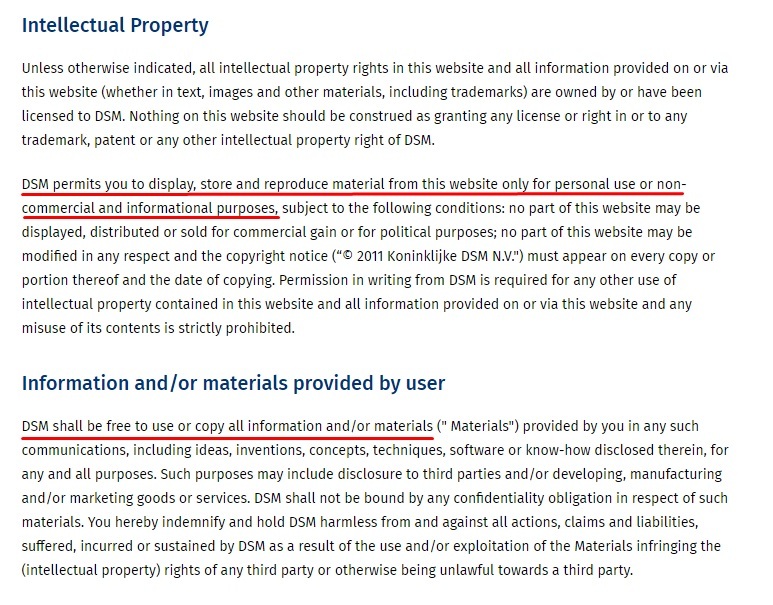
Disclaimers
While disclaimers can be displayed in a variety of ways, you can and should absolutely include them within a Terms and Conditions agreement.
You may need to include disclaimers that address the following:
- You are not responsible for any consequences of users following advice or information on your site.
- You cannot guarantee the information on your site is accurate.
- Information on your site does not constitute professional advice or create a professional relationship with readers. This is particularly important with medical, financial or legal information.
- You cannot guarantee the site and service will always be available.
- You are not responsible for material users post on the site.
Hammond, Kennedy, Whitney and Company, Inc gives some specific disclaimers relating to its industry as well as a general disclaimer on the accuracy of information:
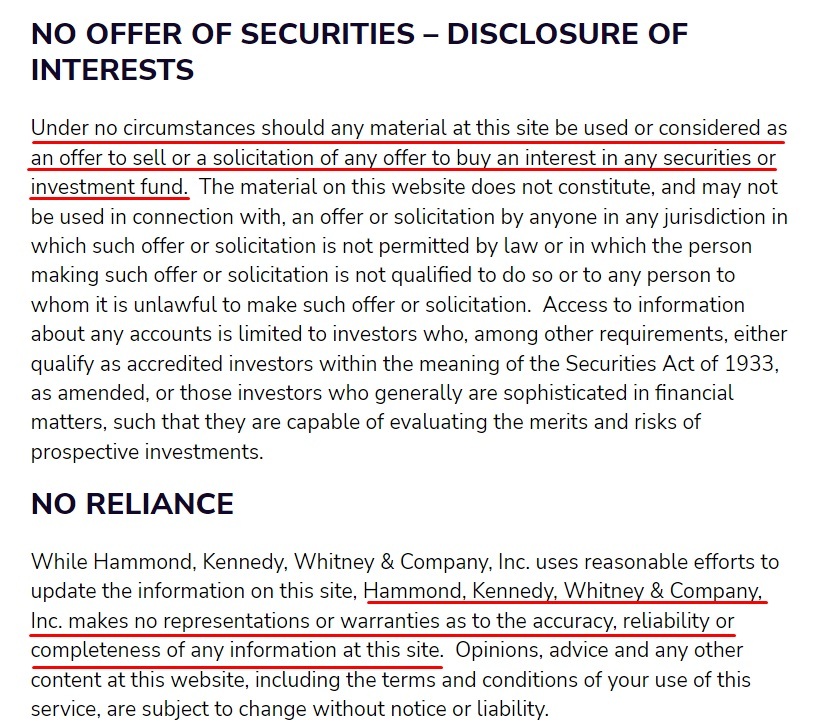
Payment Terms
You may need to address the following:
- When payment is due. This could be when placing an order, when receiving the goods, or a set number of days after either of these.
- The consequences of not paying on time such as interest, late fees or service withdrawal.
- The currency used and what happens if exchange rates change between the order date and payment date.
Keywords Studios sets out some key payment terms for users to easily find:
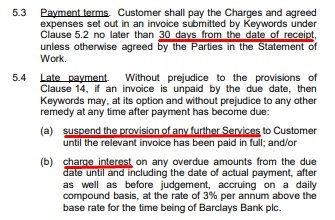
Returns Terms
While you can have a separate Return and Refund Policy, you can and should still use your T&C to set out a summary of the following details:
- The reasons for which you will accept returns
- The deadline for making a return (including if this varies in different circumstances)
- Who pays delivery costs to return goods
- Any rules on the condition of returned goods or packaging
- Any exceptions to your standard returns rules (for example, excluding personalized or custom goods)
- How you will issue a refund (such as refund the payment card or issue a check, credit note or gift voucher) and whether the refund includes the original delivery costs
- Whether your policy affects or goes beyond the customer's return rights under the law (sometimes called statutory rights)
ASOS gives a clearly written explanation including key time limits:
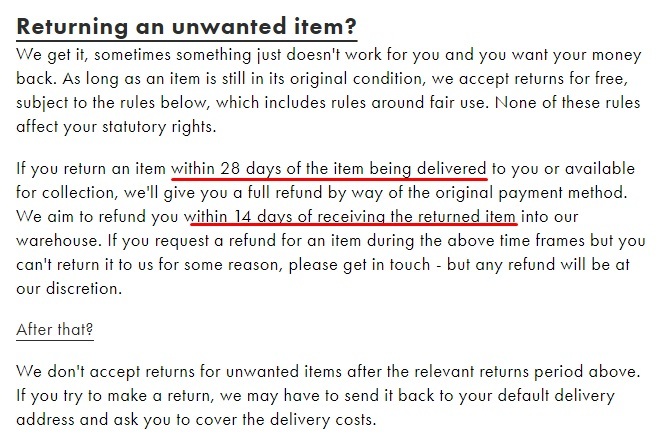
Liability and Warranty Disclaimers
Your Terms and Conditions agreement is the perfect place to outline and disclose your disclaimers of warranty and limitations of liability clauses.
Liability disclaimers are where you state that you are not taking responsibility for something, most commonly physical or financial damage. This could cover cases where customers use goods for something other than their stated purpose, do not follow instructions, or try to disassemble or modify the goods.
Warranty disclaimers mean you make clear you are not promising something. This could mean saying you make no warranty that the goods will work in a particular way or that they will perform a particular task. Warranties are a specific promise that goods will work for a set period (usually beyond any minimum legal requirement) and that you will put things right if they stop working. This could mean a repair, replacement or refund. Often warranties are complex enough that you cover them in a standalone document rather than in your Terms and Conditions agreement.
AwareX gives a comprehensive list of liabilities which it limits:
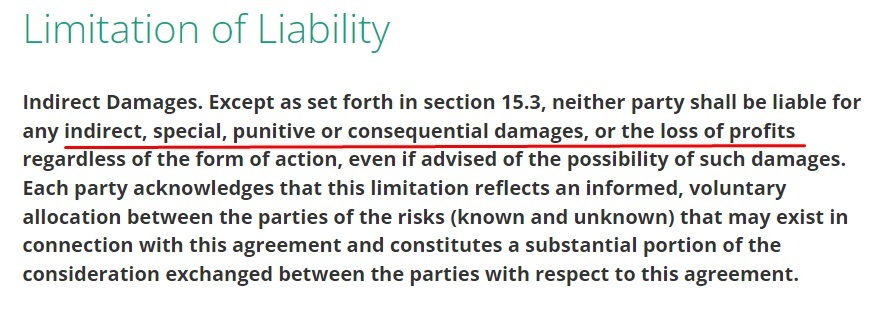
Governing Law and Jurisdiction
You may choose to set out terms for how to resolve any legal disputes that may arise. This could include:
- Which jurisdiction's laws apply to the contract
- Which court system the customer must use to bring any claim against you
- Whether the customer must use arbitration before (or instead of) pursuing court action
Discord sets out how and where any disputes must be resolved:
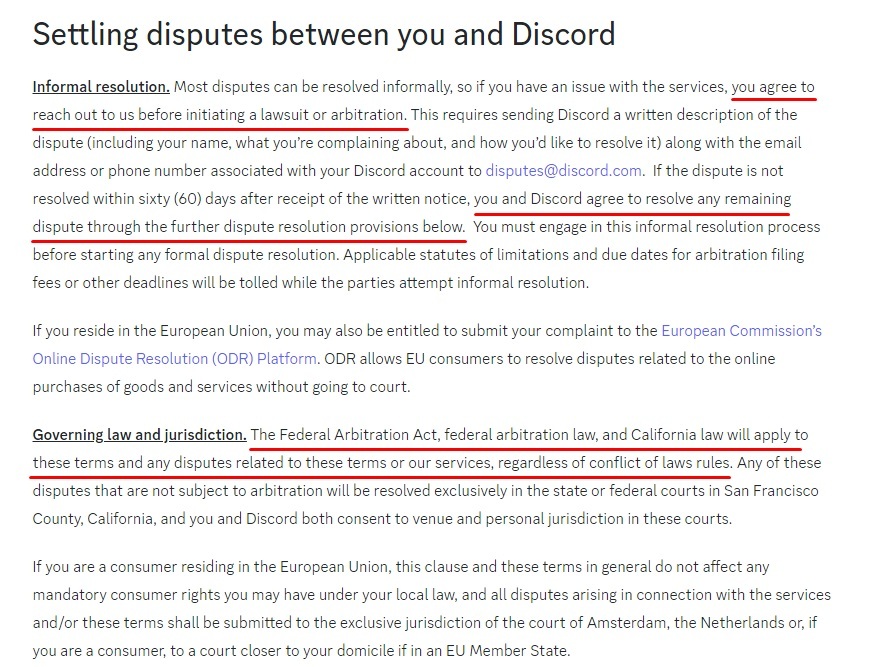
After your Terms and Conditions agreement is drafted and ready to go, it's time to display it on your WordPress site.
Where to Display a Terms and Conditions Agreement

When displaying a Terms and Conditions agreement on your WordPress site, you can set it up as a dedicated page that you can then link to your site footer and elsewhere.
You should add a link to your website footer along with your other legal links, such as your Privacy Policy. Users know to look here, so it's a great choice.
Sears uses a clear link to its Terms and Conditions agreement (labelled "Terms of Service") at the bottom of every page:

Aside from the footer, other places you can display your T&C link could include:
- An order page if you sell goods or services
- At a sign-up page for any site features that require registration for an account
- Next to any forms such as leaving comments on blog posts
- At the bottom of any post or page where the Terms and Conditions could be relevant. For example, if you wrote about investments, you might need to link to terms and conditions that make clear you are not responsible for the results of investment decisions that readers make.
How to Add a Terms and Conditions Page on WordPress

Here are easy-to-follow instructions for how you can quickly create a new Terms and Conditions page for your website managed by WordPress.
Just log in to your site and follow the steps below:
-
From within the Dashboard menu, go to Pages and choose Add New:
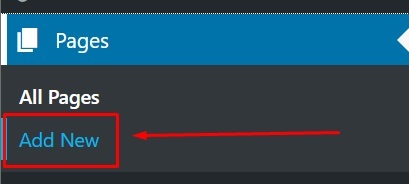
-
When the page editor opens, type "Terms and Conditions" in the title field, and then add the HTML code or text of your Terms and Conditions:
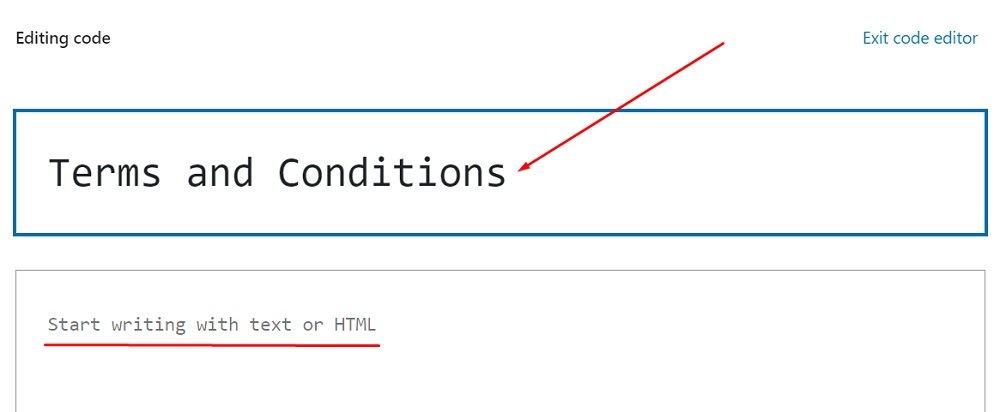
-
When you have finished, click Publish (twice).
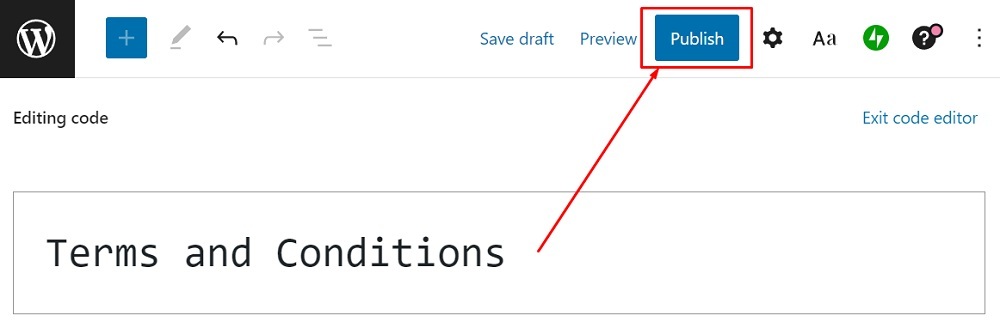
Here's an additional way to link and display your Terms and Conditions agreement using the widgets feature on WordPress
How to Link to a Terms and Conditions URL Using Widgets on WordPress

Just follow these steps to link your T&C URL via the Widgets feature.
-
Under the Dashboard menu, scroll up to Appearances and choose the Widgets option:
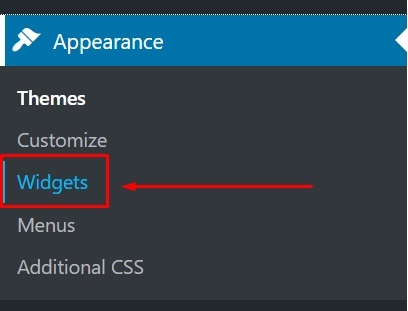
-
From the Widgets editor, under the "Footer" block section, click on the "+" icon:
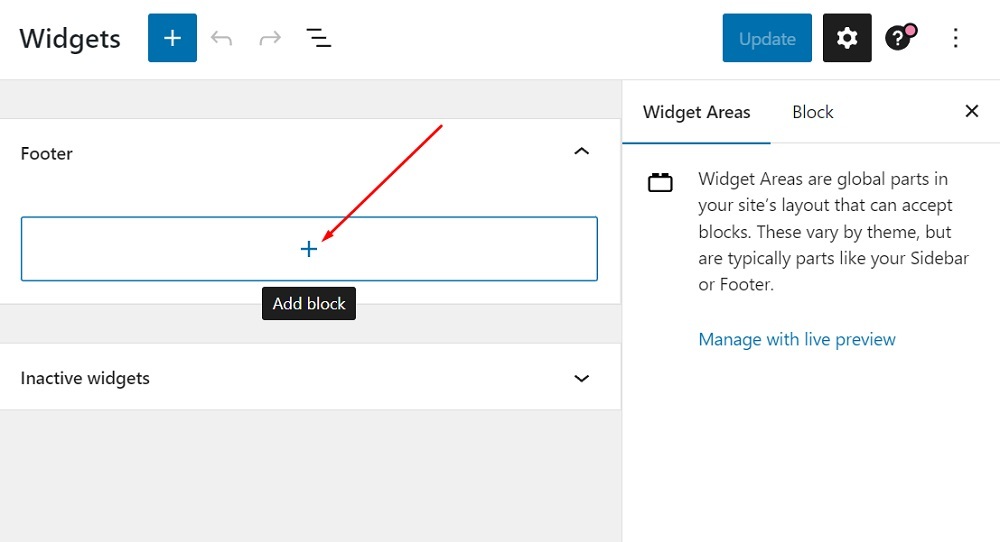
-
When the menu opens, click the Widget Group option:
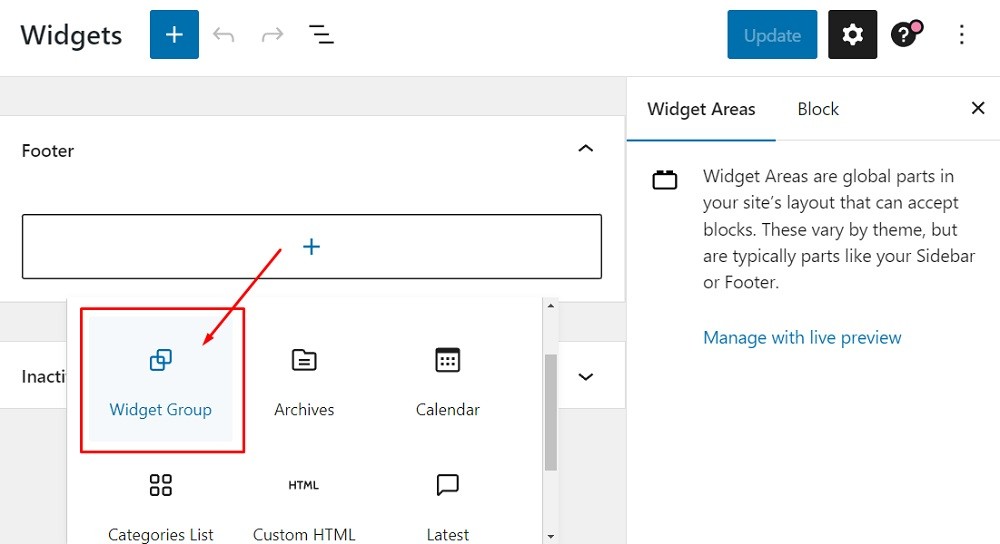
-
Click on the "+" icon and to add a new block, and then click on Paragraph:
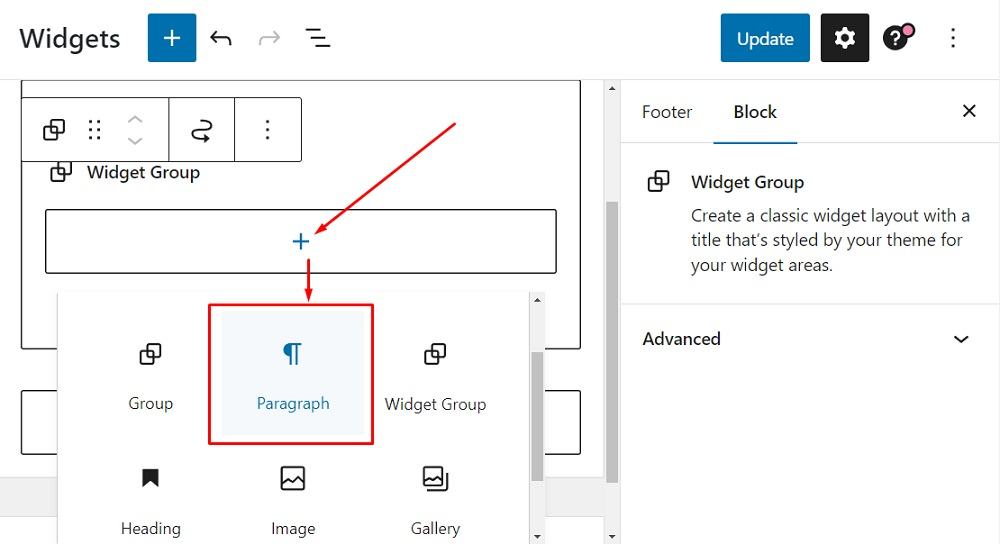
-
Type the name of your group of links (For example, "Legal"). Below it, name your agreement Terms and Conditions:
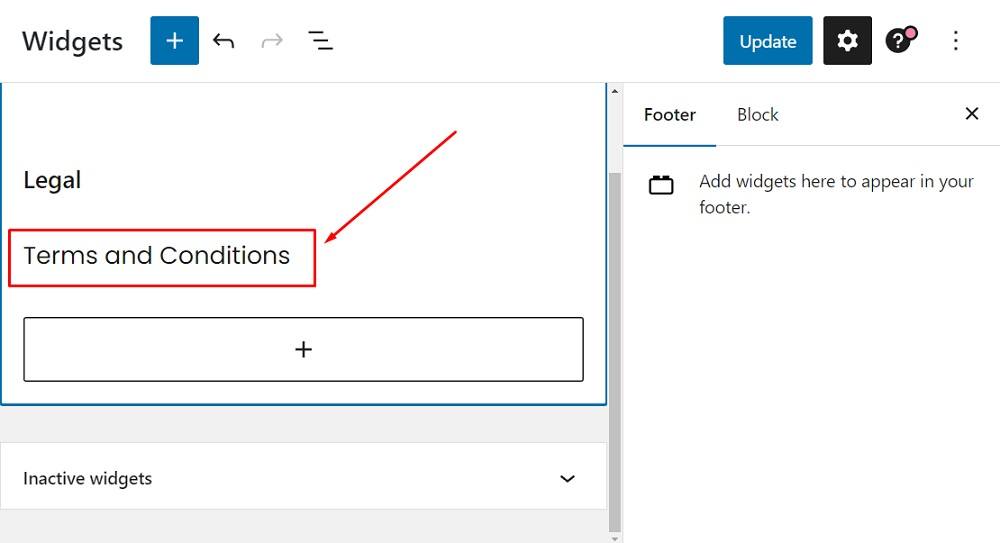
-
To add your T&C URL, select/highlight it and then click on the link icon in the formatting options menu:
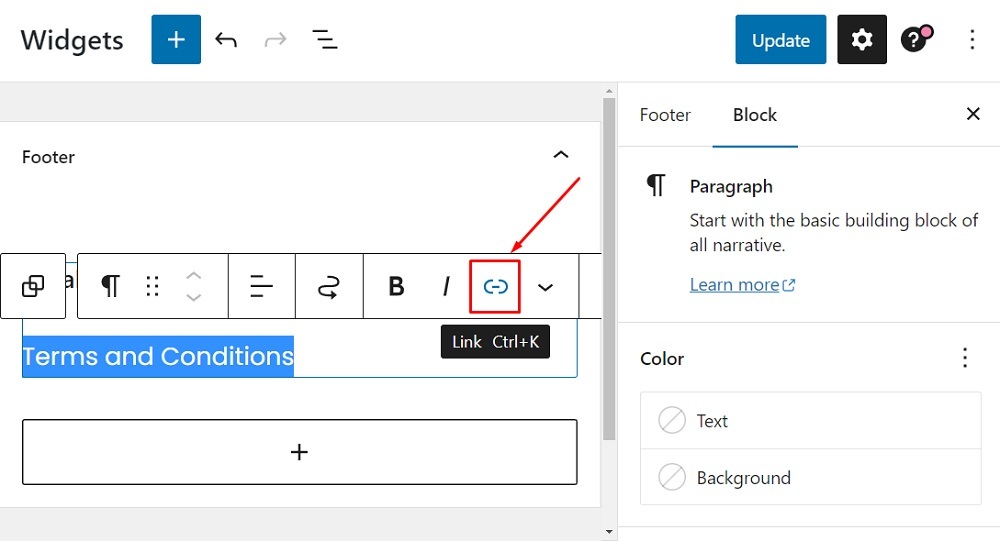
-
The new field for adding the URL will open. Paste your Terms and Conditions URL in the link field. Then click enter to add the link:
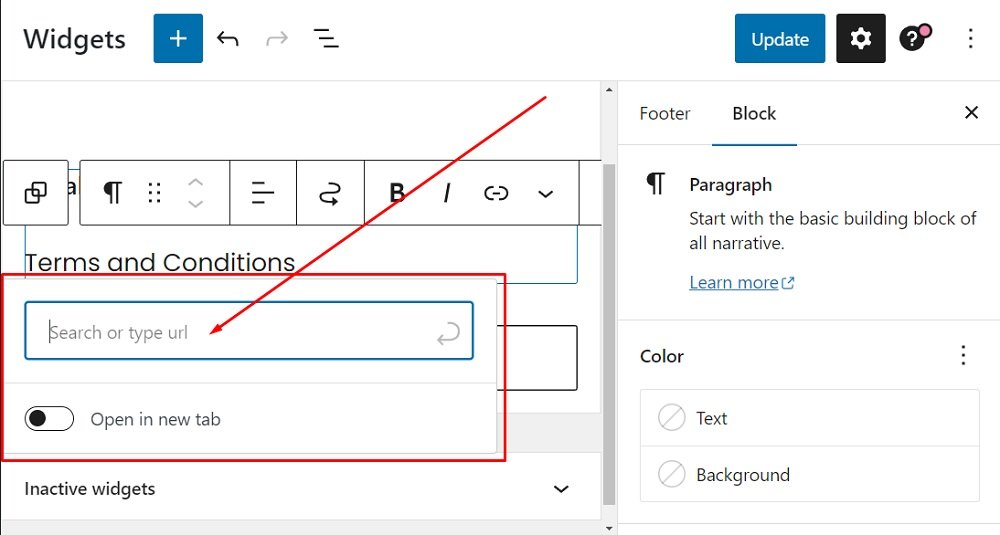
-
Click "Update" in the upper right:
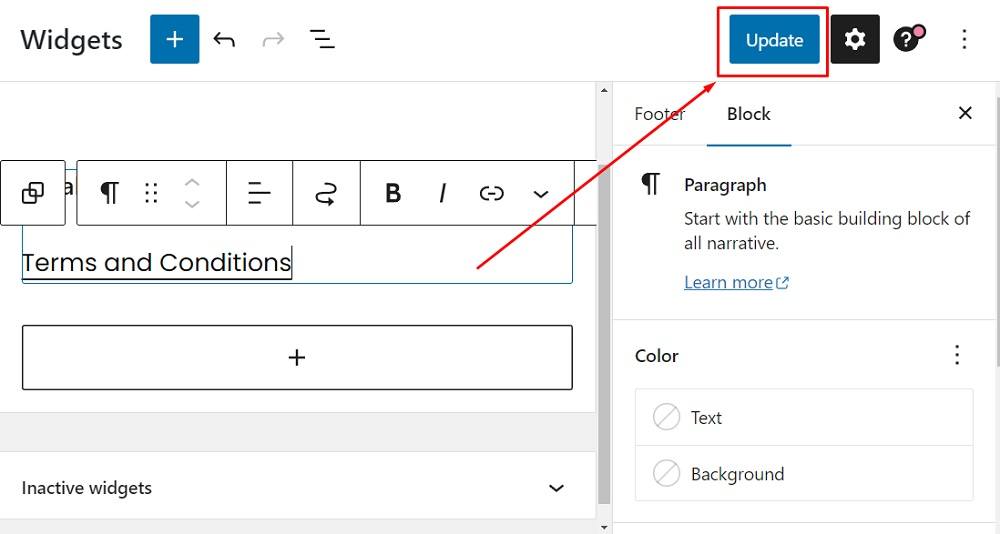
-
Your Terms and Conditions will now be linked to your site's Legal menu:
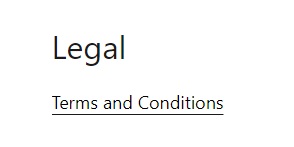
After displaying your agreement where you want it, don't forget the final step to make it enforceable: Get agreement to it. We'll show you how in this next section.
How to Get Agreement For Your Terms and Conditions Agreement

When getting agreement, it's best to get clear, active consent such as by requesting users check a box next to a statement showing that they've read and agree to the terms.
SimpliRoute uses a checkbox in the account signup form to collect user confirmation of the Terms and Conditions agreement. For added certainty it could switch to have this unchecked by default:
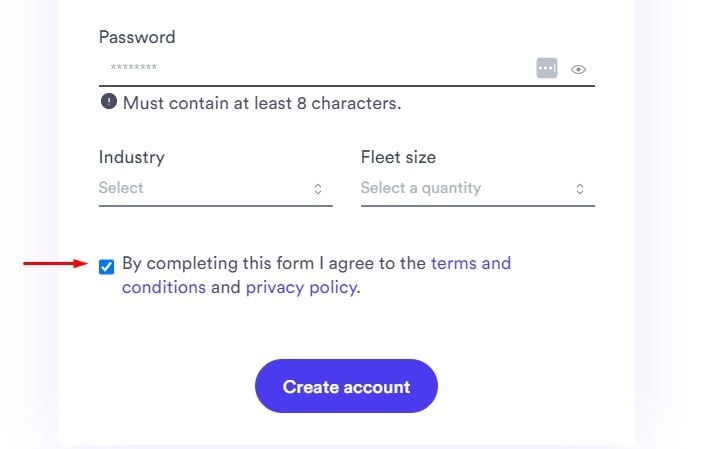
Summary
Let's recap what you need to know about Terms and Conditions agreements on your WordPress site:
- A Terms and Conditions agreement sets out details that apply to all purchases, services or other aspects of legal and business relationships. It works alongside any specific points for individual transactions.
- Using a Terms and Conditions agreement reduces ambiguity and saves the need to list terms in full for every transaction or sign-up page.
-
If you sell goods or services, a Terms and Conditions agreement should address:
- Payment terms
- Returns
- Liability and Warranty Disclaimers
- Dispute resolution
-
If you offer user features such as member sections or user-generated content, a Terms and Conditions agreement should address:
- Restrictions on user behavior
- Account termination
- Intellectual property
- Disclaimers
- The best set-up is usually to have the Terms and Conditions agreement as a dedicated page on your site and then explicitly link to it whenever a user is about to make a purchase, sign up to an account or do anything that is covered by the terms.
- For maximum certainty, require users to confirm they have read and agree to the Terms and Conditions agreement before placing an order, signing up or doing anything else covered by the agreement. A checkbox is the most effective way to be sure of the user's intentions to actually agree.

